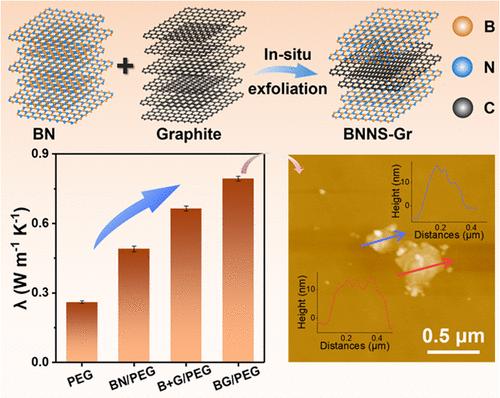基于氮化硼-石墨烯杂化填料原位剥落的电气绝缘高导热复合材料的通用构建
IF 8.2
2区 材料科学
Q1 MATERIALS SCIENCE, MULTIDISCIPLINARY
引用次数: 0
摘要
六方氮化硼(h-BN)具有优异的导热性能和绝缘性能,在电子热管理领域受到广泛关注。然而,由于界面热阻难以克服,h- bn增强聚合物复合材料的导热系数与预期相差甚远。为了实现聚合物复合热界面材料的高导热性,本文采用原位剥落法制备了氮化硼纳米片-石墨烯(BNNS-Gr)杂化填料。复合材料掺入聚乙二醇(PEG)基体后,在保证电绝缘的前提下,导热性能显著提高。此外,还构建了以该混合填料为原料的三维(3D)导热框架。通过真空浸渍法加入聚乙二醇(PEG)后,这种有序结构有效地解决了相变复合材料在实际工作条件下的泄漏问题,并在10 vol %时显示出2.45 W m-1 K-1的导热系数,以及出色的电绝缘性,形状稳定性和循环稳定性。修正的Hashin-Shtrikman模型和Foygel非线性模型证明了石墨烯与BN的复合降低了无序和有序体系的聚合物复合材料的界面热阻。这表明原位剥落策略是制备纳米填料以降低复合材料界面热阻的有效方法。本文章由计算机程序翻译,如有差异,请以英文原文为准。

Universal Construction of Electrical Insulation and High-Thermal-Conductivity Composites Based on the In Situ Exfoliation of Boron Nitride-Graphene Hybrid Filler
Hexagonal boron nitride (h-BN), with excellent thermal conductivity and insulation capability, has garnered significant attention in the field of electronic thermal management. However, the thermal conductivity of the h-BN-enhanced polymer composite material is far from that expected because of the insurmountable interfacial thermal resistance. In order to realize the high thermal conductivity of polymer composite thermal interface materials, herein, an in situ exfoliation method has been employed to prepare a boron nitride nanosheet-graphene (BNNS-Gr) hybrid filler. After being incorporated into a poly(ethylene glycol) (PEG) matrix, the thermal conductivity of composites is significantly improved on the premise of electrical insulation. Furthermore, a three-dimensional (3D) thermally conductive framework using this hybrid filler as the raw material has also been constructed. After incorporating poly(ethylene glycol) (PEG) through a vacuum impregnation method, this ordered structure effectively resolves the leakage issue in phase-change composites during actual working conditions and showcases enhanced thermal conductivity of 2.45 W m–1 K–1 at 10 vol %, along with excellent electrical insulation, shape stability, and cyclic stability. The modified Hashin–Shtrikman model and the Foygel nonlinear model prove that compounding graphene with BN reduces the interfacial thermal resistance of polymer composites for both disordered and ordered systems. This indicates that the in situ exfoliation strategy is an effective method to fabricate the nanofiller for reducing the interfacial thermal resistance of composites.
求助全文
通过发布文献求助,成功后即可免费获取论文全文。
去求助
来源期刊

ACS Applied Materials & Interfaces
工程技术-材料科学:综合
CiteScore
16.00
自引率
6.30%
发文量
4978
审稿时长
1.8 months
期刊介绍:
ACS Applied Materials & Interfaces is a leading interdisciplinary journal that brings together chemists, engineers, physicists, and biologists to explore the development and utilization of newly-discovered materials and interfacial processes for specific applications. Our journal has experienced remarkable growth since its establishment in 2009, both in terms of the number of articles published and the impact of the research showcased. We are proud to foster a truly global community, with the majority of published articles originating from outside the United States, reflecting the rapid growth of applied research worldwide.
 求助内容:
求助内容: 应助结果提醒方式:
应助结果提醒方式:


